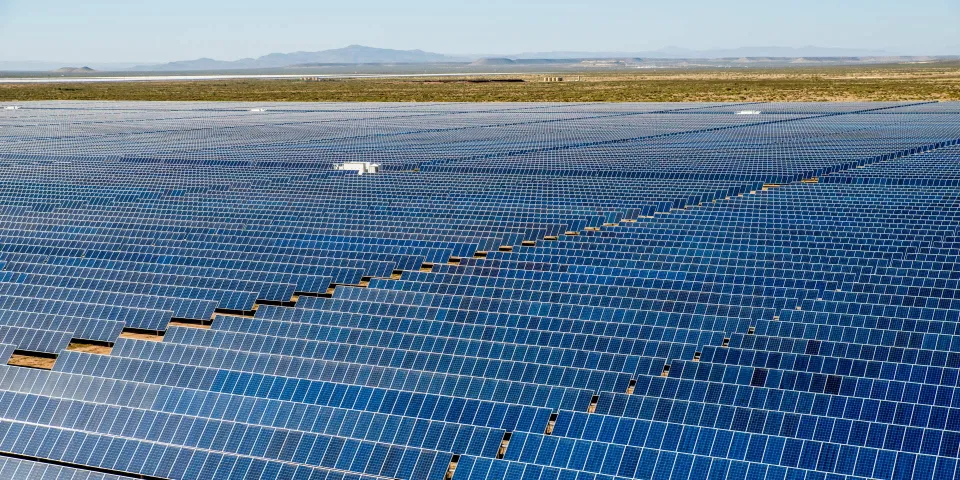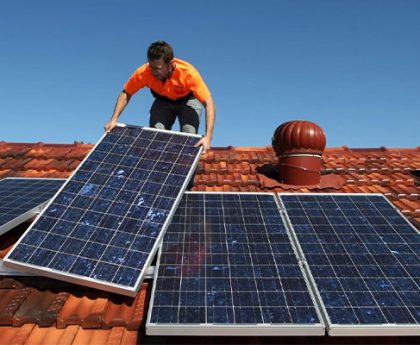Solar panels are the newest cash crop to be planted in farm fields. That’s right — solar farms are sprouting up across America come in a variety of sizes and shapes, from tiny ones that illuminate small local communities to enormous, utility-scale solar farms that power thousands of homes. We will go over the types, benefits, and costs of solar farms.
The grid currently has access to 15.7 million homes’ worth of solar energy. Now, that’s a lot of electricity from sunshine to go around.
Let’s talk more about solar farms, the various kinds of farms that are available, and the specifics like the price, the power output, and other things.
Table of Contents
What is a Solar Farm?
Solar farms are large scale solar installations where photovoltaic (PV) panels, referred to as solar panels, or other means of collecting solar energy, like concentrating solar systems are used to harvest the suns power.
Solar farms, also known as solar parks or photovoltaic power stations, are typically mounted to the ground rather than rooftops and come in a variety of sizes.
Solar parks and solar power plants are other names for solar farms. They function as power plants, just like a natural gas power plant or other sources of energy that have produced electricity for consumers for the past century.
Types of Solar Farms
In the United States, there are thousands of installations of solar panels., they can be grouped into two types of solar farms, both based on size.
- Utility-scale
- Community solar
Utility-Scale Solar Power

First and foremost, the phrase “utility-scale” can be a bit misleading. Technically, all solar energy projects — whether it’s a few rooftop panels or a whole acre of them — are “on the grid” providing the local utility company with solar-powered electricity. When a solar energy project is completely unconnected from the grid and not connected via a power line, that’s the only time it isn’t truly utility-scale. This hardly ever happens.
But for our purposes and most discussions of this nature, utility-scale solar farms refer to those massive areas of land where solar panels stretch beyond the horizon. These installations are made up of millions of solar panels that collect energy from the sun, produce an electric current, and then distribute that power along high-voltage power lines. These power lines connect to the grid, where the electricity eventually finds its way to your home.
Did we also mention that Chariot Energy has one of these? Yes, we are overjoyed to have our very own Oberon Solar Power Facility, which went live in June 2020. It is a utility-scale solar farm with a 180 megawatt (MW) capacity that can power 30,000 homes each year. Additionally, we’ll be using it for the following 25 to 30 years, so there will be plenty of sunshine for everyone.
These facilities, including ours, typically operate on power purchase agreements, wherein businesses agree to purchase a specific amount of electricity either from the utility or the generator. They also operate through other channels, like tax equity investments—a fancy term we cover in more detail in our article on solar for businesses.
The solar farm has more than one side to it. The other is made up of the numerous smaller farms that the industry refers to as solar gardens or community solar.
Community Solar Farms
Community solar farmsare small-scale solar facilities that generate around 5 MW for a neighborhood of residences and businesses. All program participants share in the power. For investing in this solar project, the residents may receive a reduction in their electricity bill depending on the population and production levels.
Here’s how it works:
- The neighborhood’s large, open space where the solar panels are located receives the most sunlight.
- The greater regional electricity grid receives the solar energy.
- The amount of energy generated in relation to the size of the home will be taken into account for those who joined the solar program when their energy bill is adjusted.
This is possible with technology called “virtual net metering.” Your retail energy provider will credit your account for the electricity your community solar farm produces in proportion to the energy use in your home.
Due to the fact that community solar is a distributed energy resource (DER), it differs from utility-scale solar in another way. The nearby homes are powered by the electricity generated by the community solar farm. As a result, if the grid fails, they are less likely to lose power.
The electricity produced by utility-scale solar farms, in contrast, can travel a great distance before arriving at its destination, be it your home or place of business. In the end, both have special advantages that advance the solar industry!
Advantages of Solar Farms
Starting or joining a solar farm can be a great way to cut costs, lessen your carbon footprint, and take advantage of the rapidly evolving solar technology. Before making a purchase, there are a few things to consider.

Environmentally Friendly
If you have the available land and resources, starting a solar farm yourself can be a worthwhile investment. Utility and community solar farms produce a lot of solar energy that is easily available. Solar energy is practically limitless and, unlike fossil fuels, doesn’t produce any negative by-products.
Require Little Maintenance
In recent years, solar panel technology has advanced significantly, and maintenance is now essentially nonexistent. Solar panels are made of strong materials that can withstand a lot of damage from the weather and only need occasional cleaning.
No Upfront Cost for Community Solar Farm Subscribers
You most likely won’t have to pay anything up front if you’re interested in joining a community solar farm. Because of this, community solar is an excellent choice for renters, people whose roofs are insufficient for solar panels, or people who want to avoid the expense of rooftop solar panels.
Disadvantages of Solar Farms
Have An Upfront Cost for Property Owners
Solar installations for homes and businesses come with a hefty initial investment. You can anticipate spending $800,000 to $1.3 million to start a solar farm for your property, but there is also the possibility of a sizable return on investment. You could earn up to $40,000 per year by selling electricity for a 1MW solar farm once it has been built.
Require a Lot of Space
Solar farms typically require a sizable amount of land (between five and seven acres), which includes space for the solar arrays and any necessary equipment, maintenance, and repair areas. The building of a solar farm could take up to five years.
Energy Storage for Solar Farms Can Be Costly
Sunlight is required for solar panels to operate. In order to collect and store the extra energy produced by solar panels, utility-scale and community solar farms need storage technology like batteries, just like solar plus storage options for homeowners. The cost of this can add up. Nevertheless, there may be financial advantages for both customers and owners who use net metering to return energy to the grid, depending on the location.
How Much Does a Solar Farm Cost?
An excellent alternative if traditional rooftop solar isn’t for you is joining a community solar farm. Contrary to the initial investment needed to install solar panels, there is typically no fee to sign up. After subscribing, you can anticipate savings of between 5 and 15 percent on your electric bill.
A solar farm is much less expensive to build on a dollar-per-watt basis than residential solar panel setups; you might pay between $0.80 and $1.30 per watt to build a solar farm as opposed to the $2.86 per watt average cost of a residential installation.
Solar farm costs can range from $800,000 to more than 1.3 million dollars, which is significantly more than the $20,020 average cost of a residential installation. But utility-scale solar panel farms will typically be at least one megawatt (MW) in size, able to power about 200 households.
Conclusion on Solar Farm
A solar farm is a big array of solar panels that supplies electricity to the grid. Although a peak output of one megawatt of power has been cited as a common standard, there is no official threshold for how many panels must be installed or how many acres of land must be used for a project to qualify as a solar farm.
Due to the lack of a standardized definition for solar farms, the majority of business representatives and government organizations refer to solar farms as utility-scale solar applications. The term “solar farms” as used in this publication only refers to initiatives that fall under the umbrella of utility-scale solar applications.
Read More:




